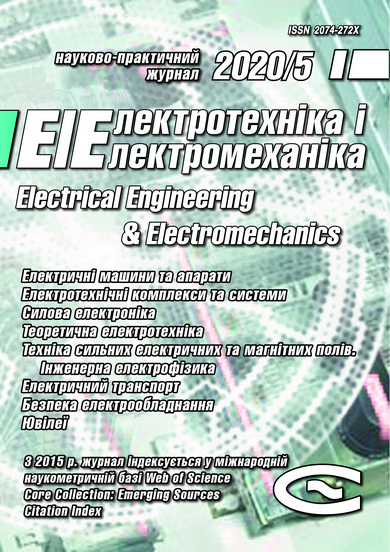ANALYSIS OF THE STATE OF THE EXTERNAL LIGHTNING PROTECTION SYSTEM FOR OPERATING ENERGY OBJECTS
DOI:
https://doi.org/10.20998/2074-272X.2020.5.10Keywords:
lightning protection, protection zone, lightning rod, energy facility, rolling sphere methodAbstract
Introduction. Within the framework of European integration of Ukraine, the international Standard IEC 62305 has been harmonized, which provides for a full inspection of lightning protection devices with a frequency of 0.5 – 4 years, which significantly increases the volume of work. Problem. The adopted Standard is stricter than those for which external lightning protection systems (LPS) of power plants and substations, which are objects of critical infrastructure, have been designed. There is no clear algorithm of actions to bring the existing LPS of existing energy facilities of Ukraine in accordance with the requirements of IEC 62305. Due to the need to modernize the existing LPS facilities, there is a need to develop a single algorithm for these works. Goal. Development of an algorithm for evaluation of the current state LPS for existing power plants and substations. Methodology. Based on the analysis of IEC 62305, three stages of evaluation are proposed: experimental (based on geodetic and electromagnetic method of determining the configuration of the object and components of LPS), calculation (based on the topographic survey method and the electromagnetic method for determining the configuration of the object and components of the LPS) and stage of analysis and development of recommendations. Results. Three stages, which are a basis of analysis of a condition of LPS based on the created algorithm, are considered in detail. An example of the analysis LPS condition of the existing substation with a voltage of 35 kV, created according to the specified method, is given. The program report in 3D form illustrates the unprotected parts of the object. Originality. For the first time, an algorithm for analysis the state of LPS of operating energy facilities according to the IEC 62305 standard has been developed. Practical value. Typical remarks to the existing LPS are formed. The results of the work can be used to inspection and modernize the LPS energy facilities, as well as buildings and structures of public importance.References
State standard of Ukraine EN 62305:2012 Protection against lightning. (IEC 62305: 2011, IDT). Kyiv, State Standard of Ukraine, 2012. 419 p. (Ukr).
Guidelines for installation of lightning protection systems for buildings and structures (RD 34.21.122-87). Moscow, Energoatomizdat Publ., 1989. 56 p. (Rus).
DSTU B V.2.5-38:2008 Lightning protection device for buildings and structures (IEC 62305:2006 NEC). Kyiv, Minrehionbud Ukraine Publ., 2008. 63 p. (Ukr).
Lyutarevich A.G., Basmanovskiy M.A., Sershanskiy V.P., Zhilenko E.P. Investigation of lightning protection of open switchgears of power stations and substations. Omsk Scientific Bulletin, 2018, no. 162, pp. 61-66. doi: 10.25206/1813-8225-2018-162-61-66.
Dyakov A.F., Kuzhekin I.P., Maksimov B.K., Temnikov A.G. Electromagnetic compatibility and lightning protection in the power. Moscow, MEI Publishing House, 2009. 455 p. (Rus).
Rizk F.A.M. Modeling of substation shielding against direct lightning strikes. IEEE Transactions on Electromagnetic Compatibility, 2010, vol. 52, no. 3, pp. 664-675. doi: 10.1109/TEMC.2010.2046903.
Kazanskiy S.V, Maltsev V.V 3D-modeling of lightning Protection systems of electrical network. Power engineering: economics, technique, ecology, 2014, no. 4 (38), pp. 78-83. (Ukr).
Analysis of modern foreign and domestic experience in the installation of lightning protection systems of the electrical objects. Kyiv, National Power Company «Ukrenergo», 2012. 75 p. (Ukr).
Kern R. Wissenschaftliche Instrumente in ihrer Zeit/Band 4: Perfektion von Optik und Mechanik. Cologne, 2010, pp. 349-360. (Ger).
IEEE Std 81-2012 Guide for Measuring Earth Resistivity, Ground Impedance, and Earth Surface Potentials of a Grounding System. New York, IEEE, 2012. 86 p. doi: 10.1109/ieeestd.2012.6392181.
Koliushko D.G., Rudenko S.S. Analysis of methods for monitoring of existing energy objects grounding devices state at the present stage. Electrical engineering & electromechanics, 2019, no. 1, pp. 67-72. doi: 10.20998/2074-272X.2019.1.11.
National Standard of Ukraine SOU 31.2-21677681-19:2009. Test and control devices, electrical grounding. Standard instruction. Kyiv, Mіnenergovugіllya Ukrayiny Publ., 2010. 54 p. (Ukr).
Koliushko G.M., Koliushko D.G., Rudenko S.S. On the problem of increasing computation accuracy for rated parameters of active electrical installation ground grids. Electrical engineering & electromechanics, 2014, no. 4, pp. 65-70. (Rus). doi: 10.20998/2074-272X.2014.4.13.
Electrical installation regulations. Kharkiv, Fort Publ., 2017. 760 p. (Ukr).
Grcev L., Markovski B. Impulse impedance and effective area of grounding grids. IEEE Transactions on Power Delivery, 2020, pp. 1-10. doi: 10.1109/tpwrd.2020.3003427.
Koliushko D.G., Rudenko S.S., Plichko A.V., Shcherbinin V.I. Modernization of the complex type IK-1U for measuring the impedance of the grounding device of a lightning arrester and supports of transmission lines. Electrical engineering & electromechanics, 2019, no.3, pp. 55-58. doi: 10.20998/2074-272X.2019.3.09.
Petcharaks N. Lightning protection zone in substation using mast. KKU engineering journal, 2013, vol. 40, no. 1, pp. 11-20. doi: 10.5481/kkuenj.2013.40.1.2.
Koliushko D.G., Istomin O.Y., Rudenko S.S., Kiprych S.V. Mathematical model of the protection zone during an arbitrary configuration of the air-termination rods location. Technical Electrodynamics, 2020, no. 1, pp. 3-9. (Ukr). doi: 10.15407/techned2020.01.003.
Downloads
Published
How to Cite
Issue
Section
License
Copyright (c) 2020 D. G. Koliushko, S. S. Rudenko, S. V. Kiprych

This work is licensed under a Creative Commons Attribution-NonCommercial 4.0 International License.
Authors who publish with this journal agree to the following terms:
1. Authors retain copyright and grant the journal right of first publication with the work simultaneously licensed under a Creative Commons Attribution License that allows others to share the work with an acknowledgement of the work's authorship and initial publication in this journal.
2. Authors are able to enter into separate, additional contractual arrangements for the non-exclusive distribution of the journal's published version of the work (e.g., post it to an institutional repository or publish it in a book), with an acknowledgement of its initial publication in this journal.
3. Authors are permitted and encouraged to post their work online (e.g., in institutional repositories or on their website) prior to and during the submission process, as it can lead to productive exchanges, as well as earlier and greater citation of published work.





